MPM755, Trimester 1: Global Supply Chain Challenges and Solutions
VerifiedAdded on 2021/04/17
|9
|2872
|27
Report
AI Summary
This report delves into the multifaceted challenges confronting the global supply chain industry. It examines the impact of e-commerce's rapid expansion, the complexities of extracting meaningful insights from big data, and the influence of cloud computing on operational costs. The study also investigates the issues stemming from increased urban traffic congestion and population density, as well as the integration of key concepts such as warehouse management, inventory control, efficient transportation and distribution, timely delivery, and customer satisfaction. Employing an observational study approach, the research leverages secondary data analysis from journals, e-books, and research papers to provide a comprehensive understanding of these challenges and offer actionable recommendations for improvement. The research questions are addressed through an analysis of existing studies and evaluation of the randomized experiment. The report culminates in recommendations for adapting to these evolving challenges, emphasizing the need for strategic adjustments in response to technological advancements and competitive pressures within the global supply chain landscape.
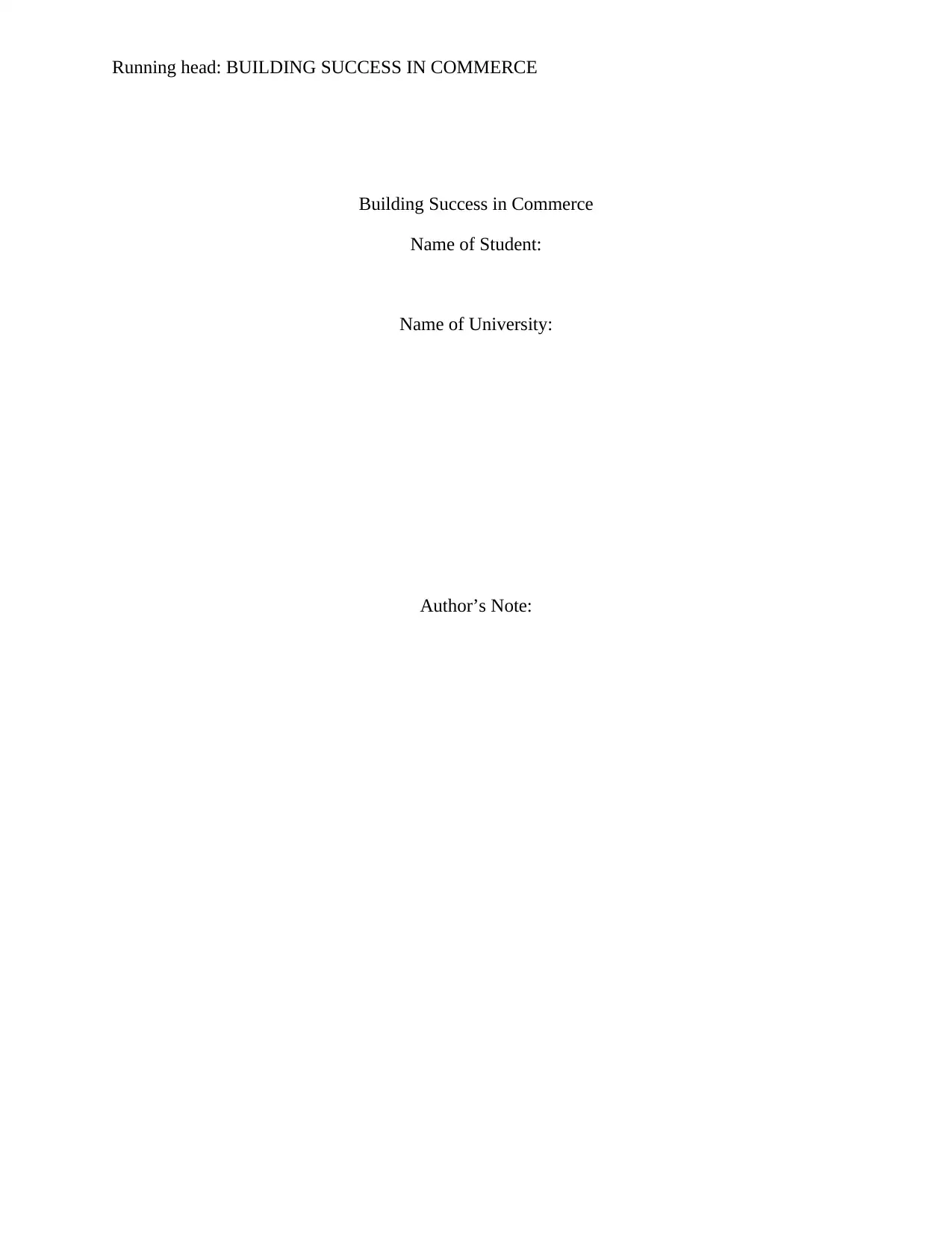
Running head: BUILDING SUCCESS IN COMMERCE
Building Success in Commerce
Name of Student:
Name of University:
Author’s Note:
Building Success in Commerce
Name of Student:
Name of University:
Author’s Note:
Paraphrase This Document
Need a fresh take? Get an instant paraphrase of this document with our AI Paraphraser
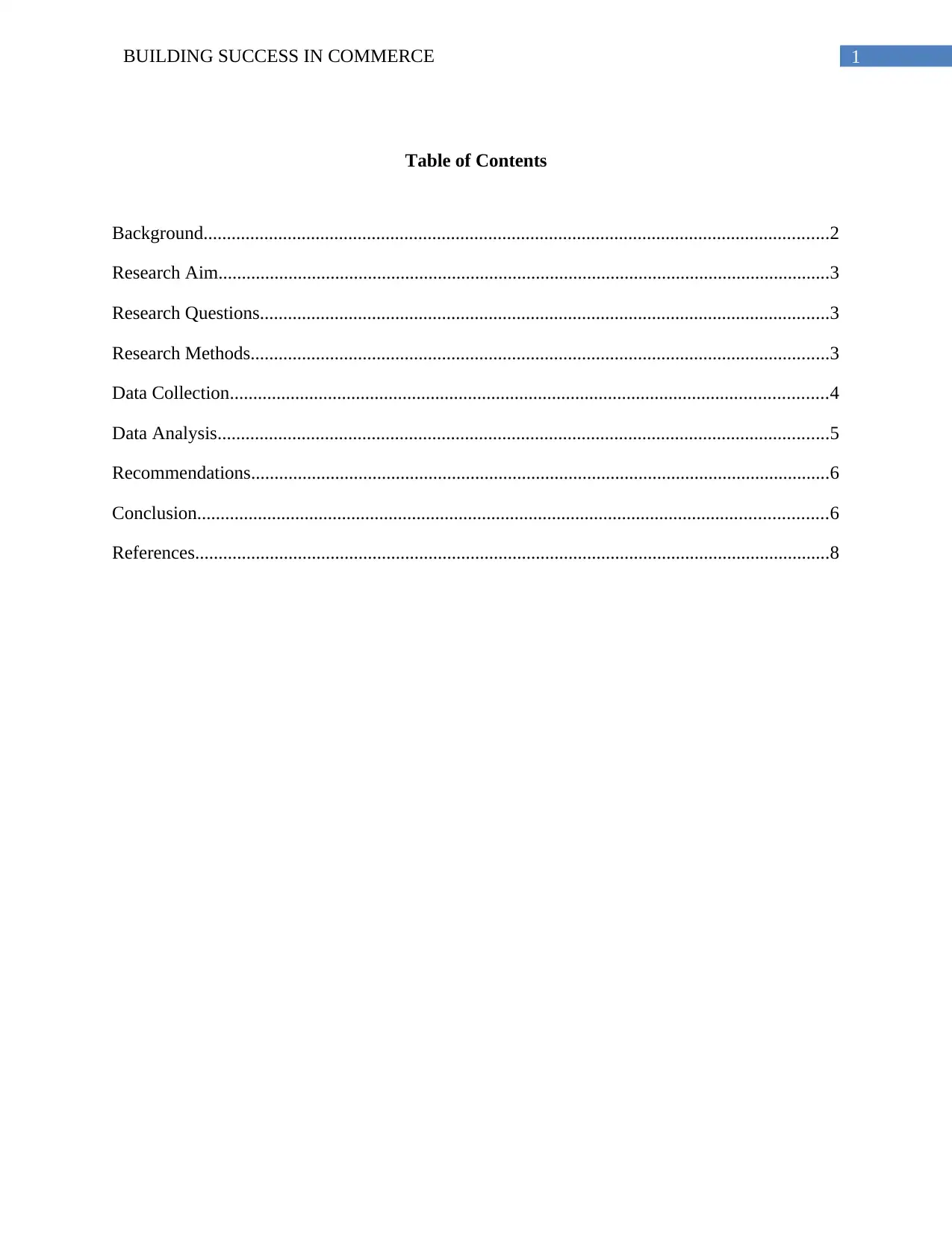
1BUILDING SUCCESS IN COMMERCE
Table of Contents
Background......................................................................................................................................2
Research Aim...................................................................................................................................3
Research Questions..........................................................................................................................3
Research Methods............................................................................................................................3
Data Collection................................................................................................................................4
Data Analysis...................................................................................................................................5
Recommendations............................................................................................................................6
Conclusion.......................................................................................................................................6
References........................................................................................................................................8
Table of Contents
Background......................................................................................................................................2
Research Aim...................................................................................................................................3
Research Questions..........................................................................................................................3
Research Methods............................................................................................................................3
Data Collection................................................................................................................................4
Data Analysis...................................................................................................................................5
Recommendations............................................................................................................................6
Conclusion.......................................................................................................................................6
References........................................................................................................................................8
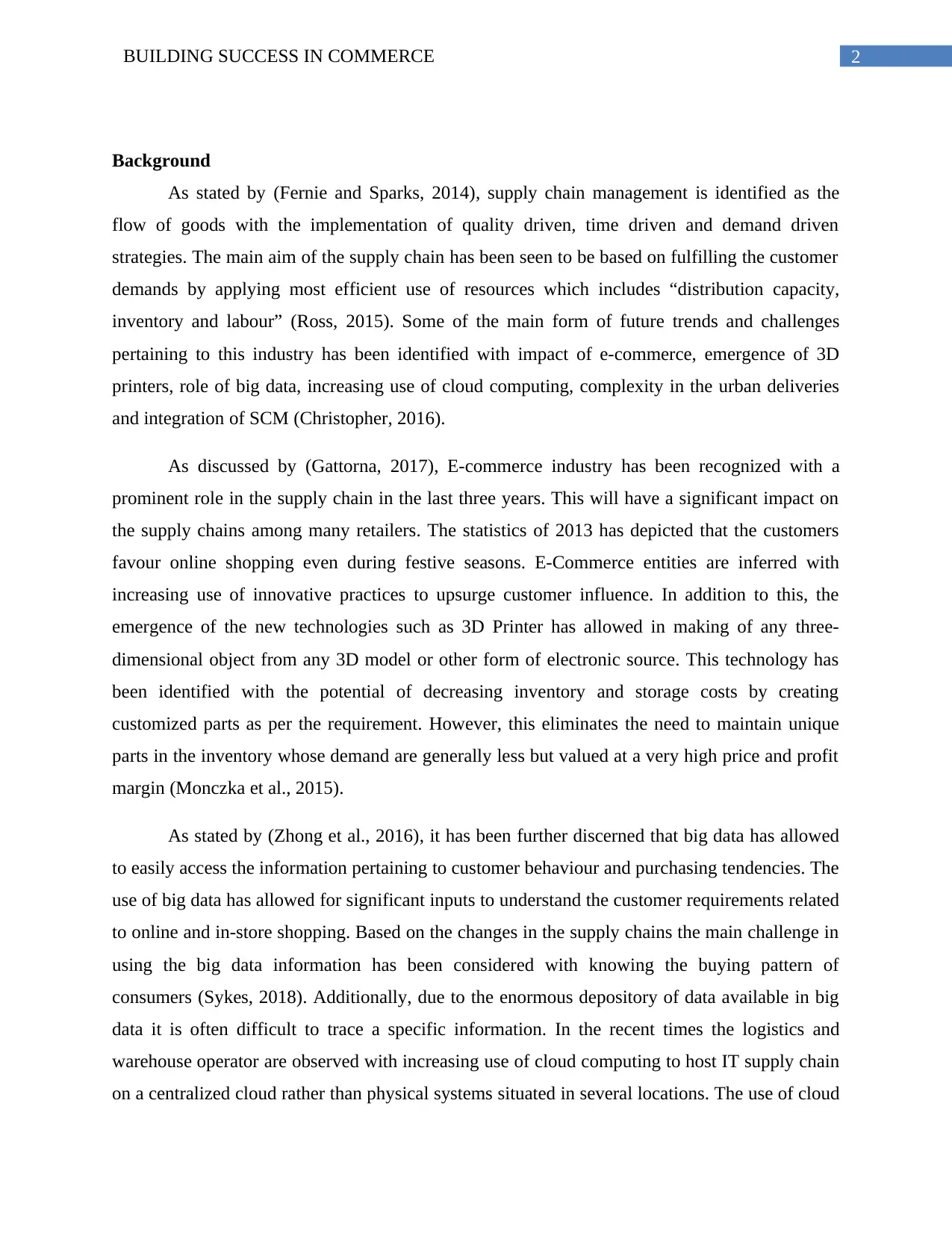
2BUILDING SUCCESS IN COMMERCE
Background
As stated by (Fernie and Sparks, 2014), supply chain management is identified as the
flow of goods with the implementation of quality driven, time driven and demand driven
strategies. The main aim of the supply chain has been seen to be based on fulfilling the customer
demands by applying most efficient use of resources which includes “distribution capacity,
inventory and labour” (Ross, 2015). Some of the main form of future trends and challenges
pertaining to this industry has been identified with impact of e-commerce, emergence of 3D
printers, role of big data, increasing use of cloud computing, complexity in the urban deliveries
and integration of SCM (Christopher, 2016).
As discussed by (Gattorna, 2017), E-commerce industry has been recognized with a
prominent role in the supply chain in the last three years. This will have a significant impact on
the supply chains among many retailers. The statistics of 2013 has depicted that the customers
favour online shopping even during festive seasons. E-Commerce entities are inferred with
increasing use of innovative practices to upsurge customer influence. In addition to this, the
emergence of the new technologies such as 3D Printer has allowed in making of any three-
dimensional object from any 3D model or other form of electronic source. This technology has
been identified with the potential of decreasing inventory and storage costs by creating
customized parts as per the requirement. However, this eliminates the need to maintain unique
parts in the inventory whose demand are generally less but valued at a very high price and profit
margin (Monczka et al., 2015).
As stated by (Zhong et al., 2016), it has been further discerned that big data has allowed
to easily access the information pertaining to customer behaviour and purchasing tendencies. The
use of big data has allowed for significant inputs to understand the customer requirements related
to online and in-store shopping. Based on the changes in the supply chains the main challenge in
using the big data information has been considered with knowing the buying pattern of
consumers (Sykes, 2018). Additionally, due to the enormous depository of data available in big
data it is often difficult to trace a specific information. In the recent times the logistics and
warehouse operator are observed with increasing use of cloud computing to host IT supply chain
on a centralized cloud rather than physical systems situated in several locations. The use of cloud
Background
As stated by (Fernie and Sparks, 2014), supply chain management is identified as the
flow of goods with the implementation of quality driven, time driven and demand driven
strategies. The main aim of the supply chain has been seen to be based on fulfilling the customer
demands by applying most efficient use of resources which includes “distribution capacity,
inventory and labour” (Ross, 2015). Some of the main form of future trends and challenges
pertaining to this industry has been identified with impact of e-commerce, emergence of 3D
printers, role of big data, increasing use of cloud computing, complexity in the urban deliveries
and integration of SCM (Christopher, 2016).
As discussed by (Gattorna, 2017), E-commerce industry has been recognized with a
prominent role in the supply chain in the last three years. This will have a significant impact on
the supply chains among many retailers. The statistics of 2013 has depicted that the customers
favour online shopping even during festive seasons. E-Commerce entities are inferred with
increasing use of innovative practices to upsurge customer influence. In addition to this, the
emergence of the new technologies such as 3D Printer has allowed in making of any three-
dimensional object from any 3D model or other form of electronic source. This technology has
been identified with the potential of decreasing inventory and storage costs by creating
customized parts as per the requirement. However, this eliminates the need to maintain unique
parts in the inventory whose demand are generally less but valued at a very high price and profit
margin (Monczka et al., 2015).
As stated by (Zhong et al., 2016), it has been further discerned that big data has allowed
to easily access the information pertaining to customer behaviour and purchasing tendencies. The
use of big data has allowed for significant inputs to understand the customer requirements related
to online and in-store shopping. Based on the changes in the supply chains the main challenge in
using the big data information has been considered with knowing the buying pattern of
consumers (Sykes, 2018). Additionally, due to the enormous depository of data available in big
data it is often difficult to trace a specific information. In the recent times the logistics and
warehouse operator are observed with increasing use of cloud computing to host IT supply chain
on a centralized cloud rather than physical systems situated in several locations. The use of cloud
⊘ This is a preview!⊘
Do you want full access?
Subscribe today to unlock all pages.

Trusted by 1+ million students worldwide
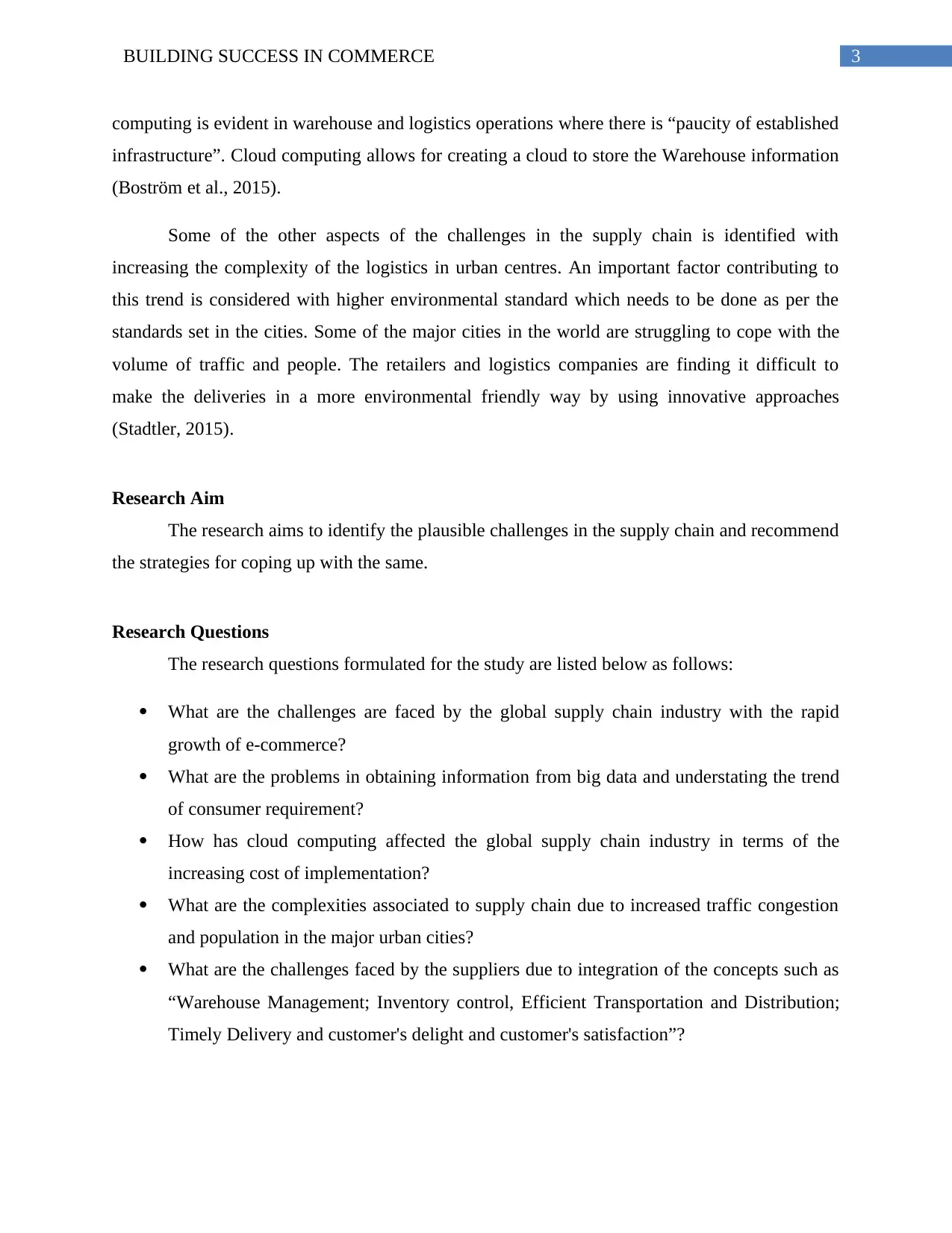
3BUILDING SUCCESS IN COMMERCE
computing is evident in warehouse and logistics operations where there is “paucity of established
infrastructure”. Cloud computing allows for creating a cloud to store the Warehouse information
(Boström et al., 2015).
Some of the other aspects of the challenges in the supply chain is identified with
increasing the complexity of the logistics in urban centres. An important factor contributing to
this trend is considered with higher environmental standard which needs to be done as per the
standards set in the cities. Some of the major cities in the world are struggling to cope with the
volume of traffic and people. The retailers and logistics companies are finding it difficult to
make the deliveries in a more environmental friendly way by using innovative approaches
(Stadtler, 2015).
Research Aim
The research aims to identify the plausible challenges in the supply chain and recommend
the strategies for coping up with the same.
Research Questions
The research questions formulated for the study are listed below as follows:
What are the challenges are faced by the global supply chain industry with the rapid
growth of e-commerce?
What are the problems in obtaining information from big data and understating the trend
of consumer requirement?
How has cloud computing affected the global supply chain industry in terms of the
increasing cost of implementation?
What are the complexities associated to supply chain due to increased traffic congestion
and population in the major urban cities?
What are the challenges faced by the suppliers due to integration of the concepts such as
“Warehouse Management; Inventory control, Efficient Transportation and Distribution;
Timely Delivery and customer's delight and customer's satisfaction”?
computing is evident in warehouse and logistics operations where there is “paucity of established
infrastructure”. Cloud computing allows for creating a cloud to store the Warehouse information
(Boström et al., 2015).
Some of the other aspects of the challenges in the supply chain is identified with
increasing the complexity of the logistics in urban centres. An important factor contributing to
this trend is considered with higher environmental standard which needs to be done as per the
standards set in the cities. Some of the major cities in the world are struggling to cope with the
volume of traffic and people. The retailers and logistics companies are finding it difficult to
make the deliveries in a more environmental friendly way by using innovative approaches
(Stadtler, 2015).
Research Aim
The research aims to identify the plausible challenges in the supply chain and recommend
the strategies for coping up with the same.
Research Questions
The research questions formulated for the study are listed below as follows:
What are the challenges are faced by the global supply chain industry with the rapid
growth of e-commerce?
What are the problems in obtaining information from big data and understating the trend
of consumer requirement?
How has cloud computing affected the global supply chain industry in terms of the
increasing cost of implementation?
What are the complexities associated to supply chain due to increased traffic congestion
and population in the major urban cities?
What are the challenges faced by the suppliers due to integration of the concepts such as
“Warehouse Management; Inventory control, Efficient Transportation and Distribution;
Timely Delivery and customer's delight and customer's satisfaction”?
Paraphrase This Document
Need a fresh take? Get an instant paraphrase of this document with our AI Paraphraser
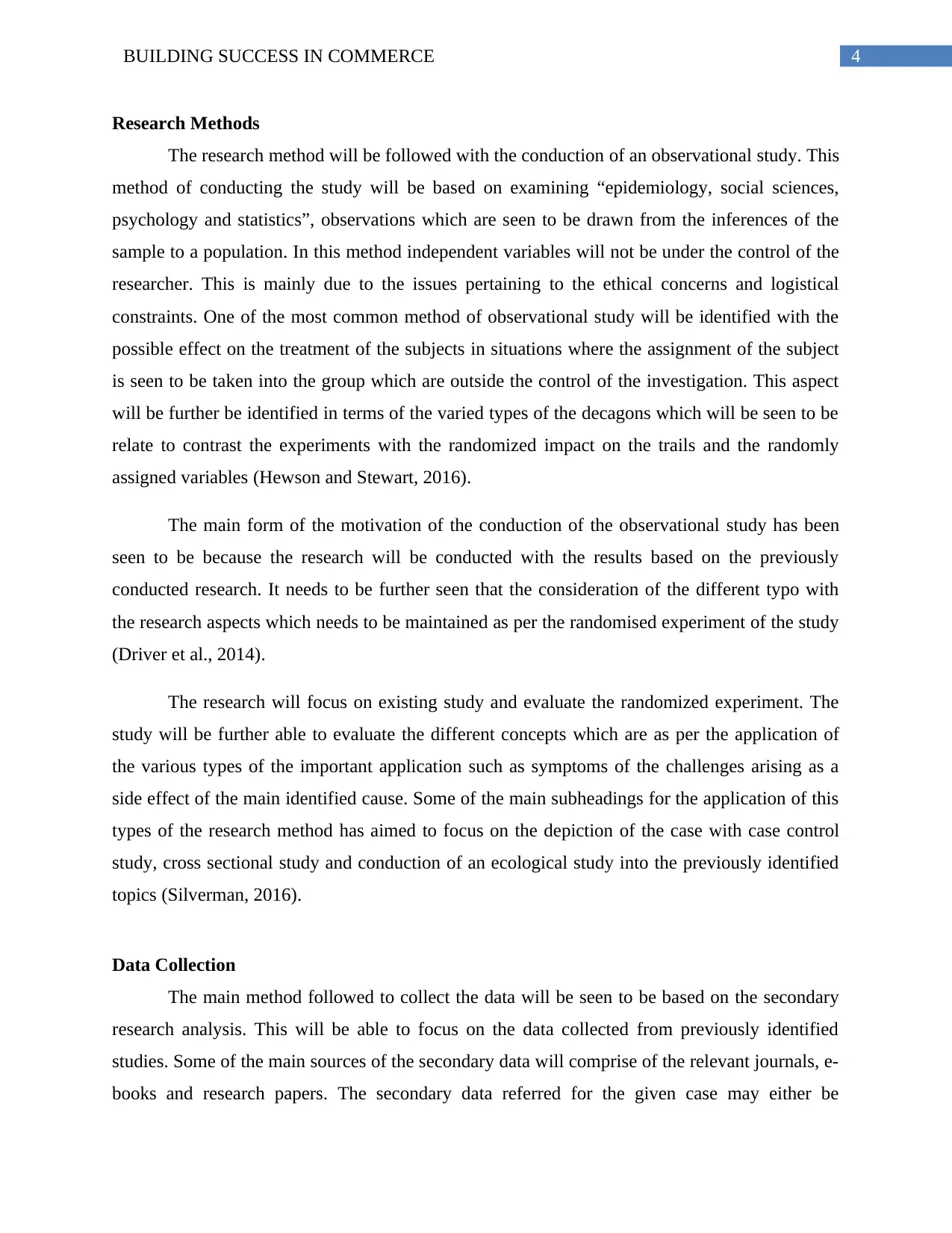
4BUILDING SUCCESS IN COMMERCE
Research Methods
The research method will be followed with the conduction of an observational study. This
method of conducting the study will be based on examining “epidemiology, social sciences,
psychology and statistics”, observations which are seen to be drawn from the inferences of the
sample to a population. In this method independent variables will not be under the control of the
researcher. This is mainly due to the issues pertaining to the ethical concerns and logistical
constraints. One of the most common method of observational study will be identified with the
possible effect on the treatment of the subjects in situations where the assignment of the subject
is seen to be taken into the group which are outside the control of the investigation. This aspect
will be further be identified in terms of the varied types of the decagons which will be seen to be
relate to contrast the experiments with the randomized impact on the trails and the randomly
assigned variables (Hewson and Stewart, 2016).
The main form of the motivation of the conduction of the observational study has been
seen to be because the research will be conducted with the results based on the previously
conducted research. It needs to be further seen that the consideration of the different typo with
the research aspects which needs to be maintained as per the randomised experiment of the study
(Driver et al., 2014).
The research will focus on existing study and evaluate the randomized experiment. The
study will be further able to evaluate the different concepts which are as per the application of
the various types of the important application such as symptoms of the challenges arising as a
side effect of the main identified cause. Some of the main subheadings for the application of this
types of the research method has aimed to focus on the depiction of the case with case control
study, cross sectional study and conduction of an ecological study into the previously identified
topics (Silverman, 2016).
Data Collection
The main method followed to collect the data will be seen to be based on the secondary
research analysis. This will be able to focus on the data collected from previously identified
studies. Some of the main sources of the secondary data will comprise of the relevant journals, e-
books and research papers. The secondary data referred for the given case may either be
Research Methods
The research method will be followed with the conduction of an observational study. This
method of conducting the study will be based on examining “epidemiology, social sciences,
psychology and statistics”, observations which are seen to be drawn from the inferences of the
sample to a population. In this method independent variables will not be under the control of the
researcher. This is mainly due to the issues pertaining to the ethical concerns and logistical
constraints. One of the most common method of observational study will be identified with the
possible effect on the treatment of the subjects in situations where the assignment of the subject
is seen to be taken into the group which are outside the control of the investigation. This aspect
will be further be identified in terms of the varied types of the decagons which will be seen to be
relate to contrast the experiments with the randomized impact on the trails and the randomly
assigned variables (Hewson and Stewart, 2016).
The main form of the motivation of the conduction of the observational study has been
seen to be because the research will be conducted with the results based on the previously
conducted research. It needs to be further seen that the consideration of the different typo with
the research aspects which needs to be maintained as per the randomised experiment of the study
(Driver et al., 2014).
The research will focus on existing study and evaluate the randomized experiment. The
study will be further able to evaluate the different concepts which are as per the application of
the various types of the important application such as symptoms of the challenges arising as a
side effect of the main identified cause. Some of the main subheadings for the application of this
types of the research method has aimed to focus on the depiction of the case with case control
study, cross sectional study and conduction of an ecological study into the previously identified
topics (Silverman, 2016).
Data Collection
The main method followed to collect the data will be seen to be based on the secondary
research analysis. This will be able to focus on the data collected from previously identified
studies. Some of the main sources of the secondary data will comprise of the relevant journals, e-
books and research papers. The secondary data referred for the given case may either be
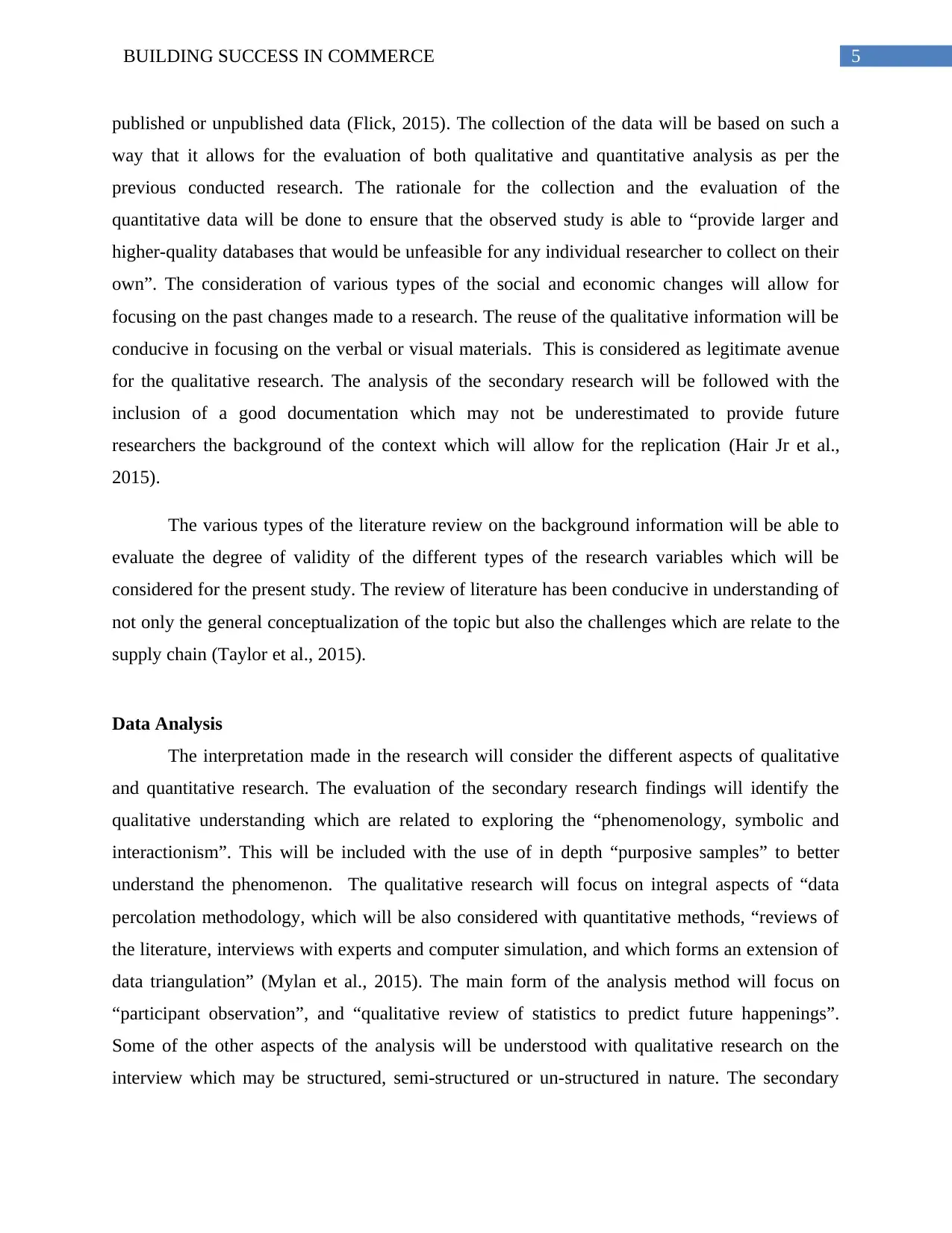
5BUILDING SUCCESS IN COMMERCE
published or unpublished data (Flick, 2015). The collection of the data will be based on such a
way that it allows for the evaluation of both qualitative and quantitative analysis as per the
previous conducted research. The rationale for the collection and the evaluation of the
quantitative data will be done to ensure that the observed study is able to “provide larger and
higher-quality databases that would be unfeasible for any individual researcher to collect on their
own”. The consideration of various types of the social and economic changes will allow for
focusing on the past changes made to a research. The reuse of the qualitative information will be
conducive in focusing on the verbal or visual materials. This is considered as legitimate avenue
for the qualitative research. The analysis of the secondary research will be followed with the
inclusion of a good documentation which may not be underestimated to provide future
researchers the background of the context which will allow for the replication (Hair Jr et al.,
2015).
The various types of the literature review on the background information will be able to
evaluate the degree of validity of the different types of the research variables which will be
considered for the present study. The review of literature has been conducive in understanding of
not only the general conceptualization of the topic but also the challenges which are relate to the
supply chain (Taylor et al., 2015).
Data Analysis
The interpretation made in the research will consider the different aspects of qualitative
and quantitative research. The evaluation of the secondary research findings will identify the
qualitative understanding which are related to exploring the “phenomenology, symbolic and
interactionism”. This will be included with the use of in depth “purposive samples” to better
understand the phenomenon. The qualitative research will focus on integral aspects of “data
percolation methodology, which will be also considered with quantitative methods, “reviews of
the literature, interviews with experts and computer simulation, and which forms an extension of
data triangulation” (Mylan et al., 2015). The main form of the analysis method will focus on
“participant observation”, and “qualitative review of statistics to predict future happenings”.
Some of the other aspects of the analysis will be understood with qualitative research on the
interview which may be structured, semi-structured or un-structured in nature. The secondary
published or unpublished data (Flick, 2015). The collection of the data will be based on such a
way that it allows for the evaluation of both qualitative and quantitative analysis as per the
previous conducted research. The rationale for the collection and the evaluation of the
quantitative data will be done to ensure that the observed study is able to “provide larger and
higher-quality databases that would be unfeasible for any individual researcher to collect on their
own”. The consideration of various types of the social and economic changes will allow for
focusing on the past changes made to a research. The reuse of the qualitative information will be
conducive in focusing on the verbal or visual materials. This is considered as legitimate avenue
for the qualitative research. The analysis of the secondary research will be followed with the
inclusion of a good documentation which may not be underestimated to provide future
researchers the background of the context which will allow for the replication (Hair Jr et al.,
2015).
The various types of the literature review on the background information will be able to
evaluate the degree of validity of the different types of the research variables which will be
considered for the present study. The review of literature has been conducive in understanding of
not only the general conceptualization of the topic but also the challenges which are relate to the
supply chain (Taylor et al., 2015).
Data Analysis
The interpretation made in the research will consider the different aspects of qualitative
and quantitative research. The evaluation of the secondary research findings will identify the
qualitative understanding which are related to exploring the “phenomenology, symbolic and
interactionism”. This will be included with the use of in depth “purposive samples” to better
understand the phenomenon. The qualitative research will focus on integral aspects of “data
percolation methodology, which will be also considered with quantitative methods, “reviews of
the literature, interviews with experts and computer simulation, and which forms an extension of
data triangulation” (Mylan et al., 2015). The main form of the analysis method will focus on
“participant observation”, and “qualitative review of statistics to predict future happenings”.
Some of the other aspects of the analysis will be understood with qualitative research on the
interview which may be structured, semi-structured or un-structured in nature. The secondary
⊘ This is a preview!⊘
Do you want full access?
Subscribe today to unlock all pages.

Trusted by 1+ million students worldwide
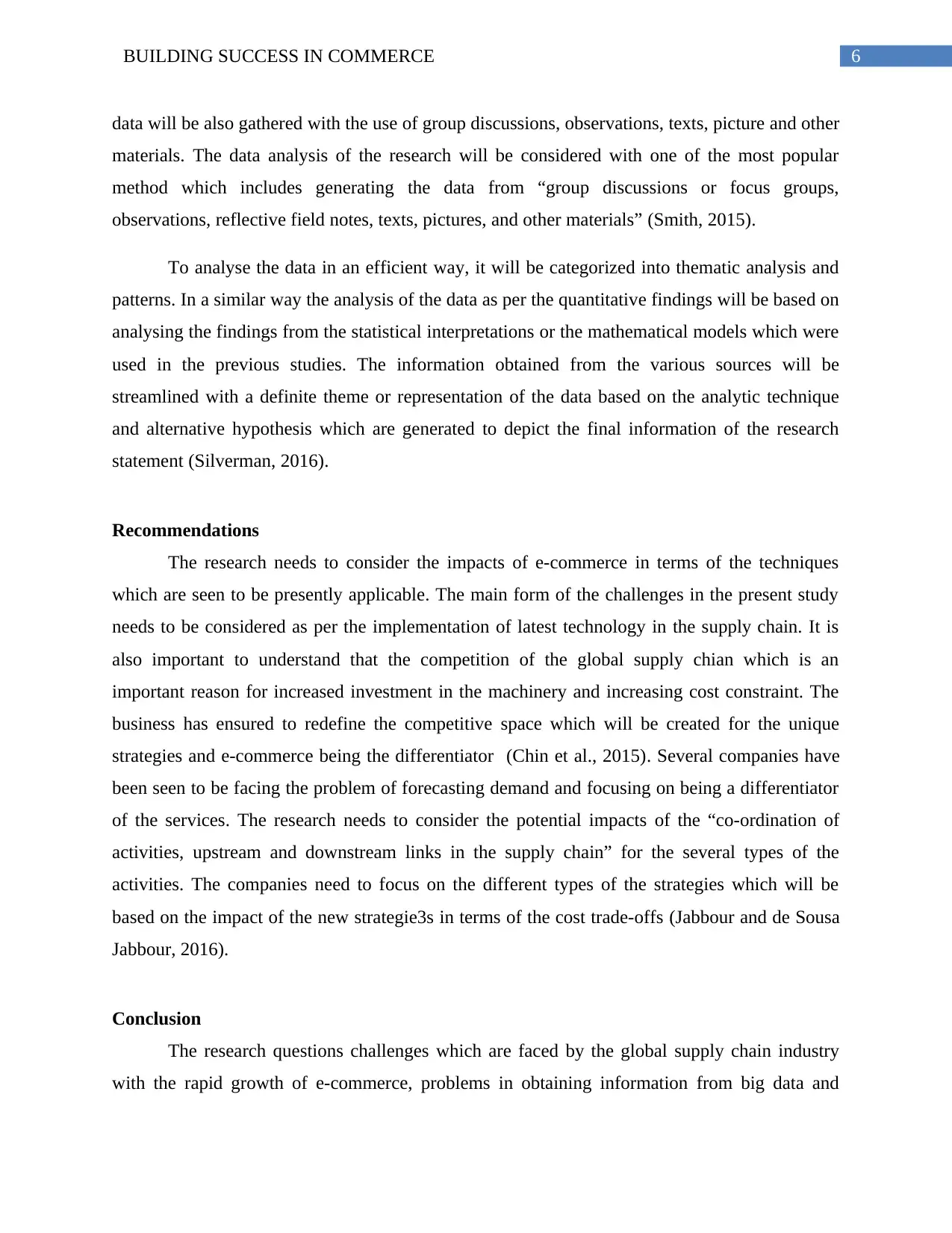
6BUILDING SUCCESS IN COMMERCE
data will be also gathered with the use of group discussions, observations, texts, picture and other
materials. The data analysis of the research will be considered with one of the most popular
method which includes generating the data from “group discussions or focus groups,
observations, reflective field notes, texts, pictures, and other materials” (Smith, 2015).
To analyse the data in an efficient way, it will be categorized into thematic analysis and
patterns. In a similar way the analysis of the data as per the quantitative findings will be based on
analysing the findings from the statistical interpretations or the mathematical models which were
used in the previous studies. The information obtained from the various sources will be
streamlined with a definite theme or representation of the data based on the analytic technique
and alternative hypothesis which are generated to depict the final information of the research
statement (Silverman, 2016).
Recommendations
The research needs to consider the impacts of e-commerce in terms of the techniques
which are seen to be presently applicable. The main form of the challenges in the present study
needs to be considered as per the implementation of latest technology in the supply chain. It is
also important to understand that the competition of the global supply chian which is an
important reason for increased investment in the machinery and increasing cost constraint. The
business has ensured to redefine the competitive space which will be created for the unique
strategies and e-commerce being the differentiator (Chin et al., 2015). Several companies have
been seen to be facing the problem of forecasting demand and focusing on being a differentiator
of the services. The research needs to consider the potential impacts of the “co-ordination of
activities, upstream and downstream links in the supply chain” for the several types of the
activities. The companies need to focus on the different types of the strategies which will be
based on the impact of the new strategie3s in terms of the cost trade-offs (Jabbour and de Sousa
Jabbour, 2016).
Conclusion
The research questions challenges which are faced by the global supply chain industry
with the rapid growth of e-commerce, problems in obtaining information from big data and
data will be also gathered with the use of group discussions, observations, texts, picture and other
materials. The data analysis of the research will be considered with one of the most popular
method which includes generating the data from “group discussions or focus groups,
observations, reflective field notes, texts, pictures, and other materials” (Smith, 2015).
To analyse the data in an efficient way, it will be categorized into thematic analysis and
patterns. In a similar way the analysis of the data as per the quantitative findings will be based on
analysing the findings from the statistical interpretations or the mathematical models which were
used in the previous studies. The information obtained from the various sources will be
streamlined with a definite theme or representation of the data based on the analytic technique
and alternative hypothesis which are generated to depict the final information of the research
statement (Silverman, 2016).
Recommendations
The research needs to consider the impacts of e-commerce in terms of the techniques
which are seen to be presently applicable. The main form of the challenges in the present study
needs to be considered as per the implementation of latest technology in the supply chain. It is
also important to understand that the competition of the global supply chian which is an
important reason for increased investment in the machinery and increasing cost constraint. The
business has ensured to redefine the competitive space which will be created for the unique
strategies and e-commerce being the differentiator (Chin et al., 2015). Several companies have
been seen to be facing the problem of forecasting demand and focusing on being a differentiator
of the services. The research needs to consider the potential impacts of the “co-ordination of
activities, upstream and downstream links in the supply chain” for the several types of the
activities. The companies need to focus on the different types of the strategies which will be
based on the impact of the new strategie3s in terms of the cost trade-offs (Jabbour and de Sousa
Jabbour, 2016).
Conclusion
The research questions challenges which are faced by the global supply chain industry
with the rapid growth of e-commerce, problems in obtaining information from big data and
Paraphrase This Document
Need a fresh take? Get an instant paraphrase of this document with our AI Paraphraser
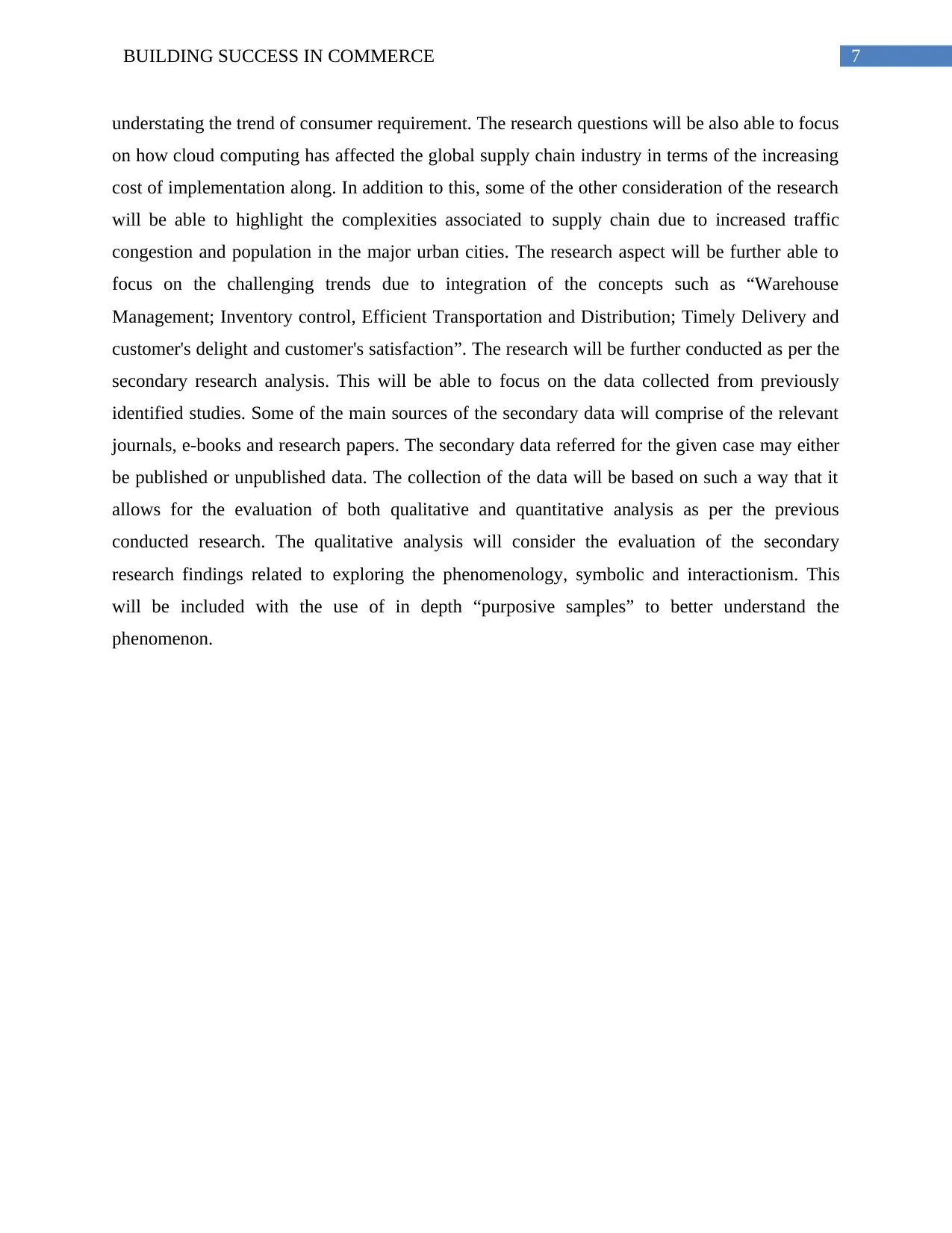
7BUILDING SUCCESS IN COMMERCE
understating the trend of consumer requirement. The research questions will be also able to focus
on how cloud computing has affected the global supply chain industry in terms of the increasing
cost of implementation along. In addition to this, some of the other consideration of the research
will be able to highlight the complexities associated to supply chain due to increased traffic
congestion and population in the major urban cities. The research aspect will be further able to
focus on the challenging trends due to integration of the concepts such as “Warehouse
Management; Inventory control, Efficient Transportation and Distribution; Timely Delivery and
customer's delight and customer's satisfaction”. The research will be further conducted as per the
secondary research analysis. This will be able to focus on the data collected from previously
identified studies. Some of the main sources of the secondary data will comprise of the relevant
journals, e-books and research papers. The secondary data referred for the given case may either
be published or unpublished data. The collection of the data will be based on such a way that it
allows for the evaluation of both qualitative and quantitative analysis as per the previous
conducted research. The qualitative analysis will consider the evaluation of the secondary
research findings related to exploring the phenomenology, symbolic and interactionism. This
will be included with the use of in depth “purposive samples” to better understand the
phenomenon.
understating the trend of consumer requirement. The research questions will be also able to focus
on how cloud computing has affected the global supply chain industry in terms of the increasing
cost of implementation along. In addition to this, some of the other consideration of the research
will be able to highlight the complexities associated to supply chain due to increased traffic
congestion and population in the major urban cities. The research aspect will be further able to
focus on the challenging trends due to integration of the concepts such as “Warehouse
Management; Inventory control, Efficient Transportation and Distribution; Timely Delivery and
customer's delight and customer's satisfaction”. The research will be further conducted as per the
secondary research analysis. This will be able to focus on the data collected from previously
identified studies. Some of the main sources of the secondary data will comprise of the relevant
journals, e-books and research papers. The secondary data referred for the given case may either
be published or unpublished data. The collection of the data will be based on such a way that it
allows for the evaluation of both qualitative and quantitative analysis as per the previous
conducted research. The qualitative analysis will consider the evaluation of the secondary
research findings related to exploring the phenomenology, symbolic and interactionism. This
will be included with the use of in depth “purposive samples” to better understand the
phenomenon.
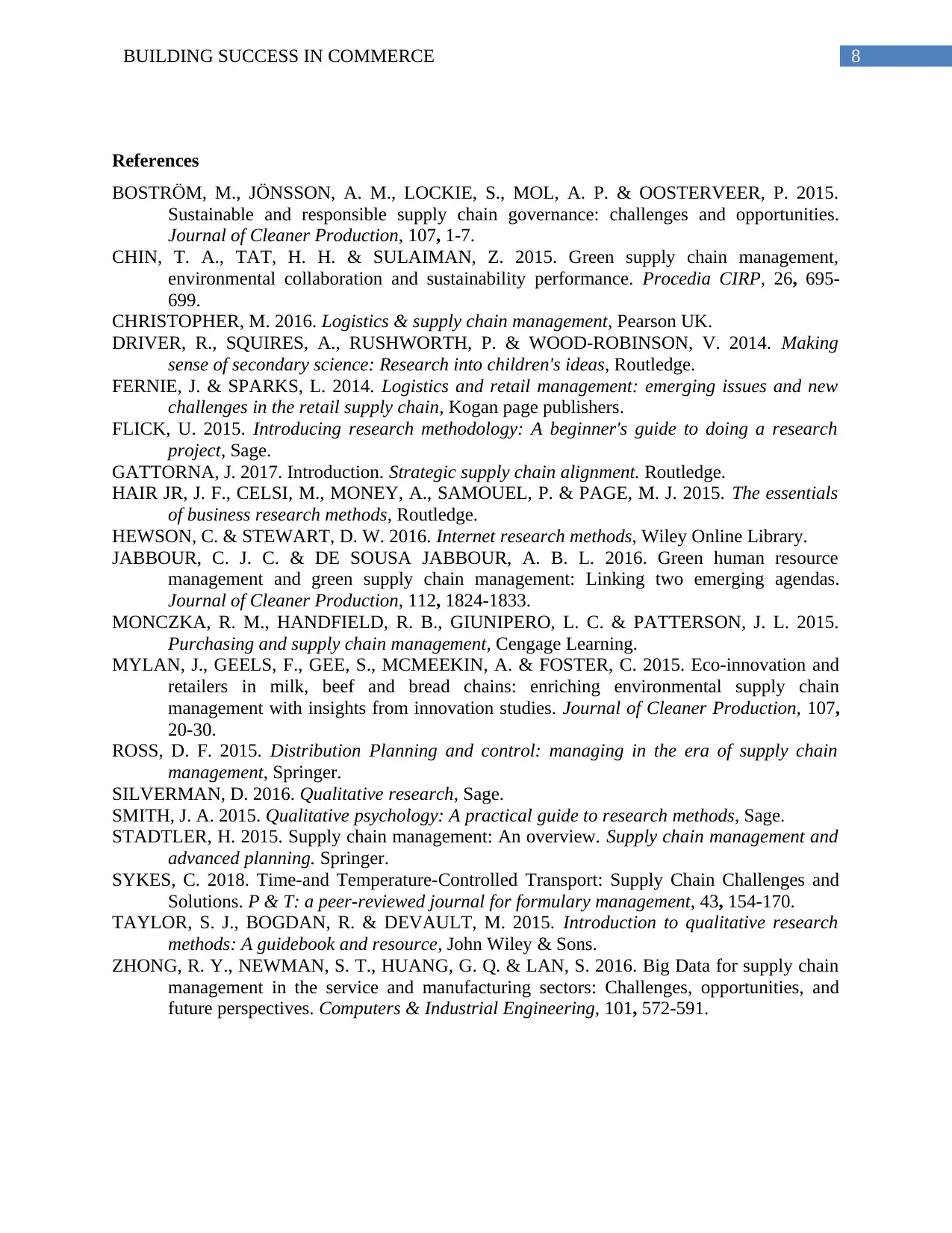
8BUILDING SUCCESS IN COMMERCE
References
BOSTRÖM, M., JÖNSSON, A. M., LOCKIE, S., MOL, A. P. & OOSTERVEER, P. 2015.
Sustainable and responsible supply chain governance: challenges and opportunities.
Journal of Cleaner Production, 107, 1-7.
CHIN, T. A., TAT, H. H. & SULAIMAN, Z. 2015. Green supply chain management,
environmental collaboration and sustainability performance. Procedia CIRP, 26, 695-
699.
CHRISTOPHER, M. 2016. Logistics & supply chain management, Pearson UK.
DRIVER, R., SQUIRES, A., RUSHWORTH, P. & WOOD-ROBINSON, V. 2014. Making
sense of secondary science: Research into children's ideas, Routledge.
FERNIE, J. & SPARKS, L. 2014. Logistics and retail management: emerging issues and new
challenges in the retail supply chain, Kogan page publishers.
FLICK, U. 2015. Introducing research methodology: A beginner's guide to doing a research
project, Sage.
GATTORNA, J. 2017. Introduction. Strategic supply chain alignment. Routledge.
HAIR JR, J. F., CELSI, M., MONEY, A., SAMOUEL, P. & PAGE, M. J. 2015. The essentials
of business research methods, Routledge.
HEWSON, C. & STEWART, D. W. 2016. Internet research methods, Wiley Online Library.
JABBOUR, C. J. C. & DE SOUSA JABBOUR, A. B. L. 2016. Green human resource
management and green supply chain management: Linking two emerging agendas.
Journal of Cleaner Production, 112, 1824-1833.
MONCZKA, R. M., HANDFIELD, R. B., GIUNIPERO, L. C. & PATTERSON, J. L. 2015.
Purchasing and supply chain management, Cengage Learning.
MYLAN, J., GEELS, F., GEE, S., MCMEEKIN, A. & FOSTER, C. 2015. Eco-innovation and
retailers in milk, beef and bread chains: enriching environmental supply chain
management with insights from innovation studies. Journal of Cleaner Production, 107,
20-30.
ROSS, D. F. 2015. Distribution Planning and control: managing in the era of supply chain
management, Springer.
SILVERMAN, D. 2016. Qualitative research, Sage.
SMITH, J. A. 2015. Qualitative psychology: A practical guide to research methods, Sage.
STADTLER, H. 2015. Supply chain management: An overview. Supply chain management and
advanced planning. Springer.
SYKES, C. 2018. Time-and Temperature-Controlled Transport: Supply Chain Challenges and
Solutions. P & T: a peer-reviewed journal for formulary management, 43, 154-170.
TAYLOR, S. J., BOGDAN, R. & DEVAULT, M. 2015. Introduction to qualitative research
methods: A guidebook and resource, John Wiley & Sons.
ZHONG, R. Y., NEWMAN, S. T., HUANG, G. Q. & LAN, S. 2016. Big Data for supply chain
management in the service and manufacturing sectors: Challenges, opportunities, and
future perspectives. Computers & Industrial Engineering, 101, 572-591.
References
BOSTRÖM, M., JÖNSSON, A. M., LOCKIE, S., MOL, A. P. & OOSTERVEER, P. 2015.
Sustainable and responsible supply chain governance: challenges and opportunities.
Journal of Cleaner Production, 107, 1-7.
CHIN, T. A., TAT, H. H. & SULAIMAN, Z. 2015. Green supply chain management,
environmental collaboration and sustainability performance. Procedia CIRP, 26, 695-
699.
CHRISTOPHER, M. 2016. Logistics & supply chain management, Pearson UK.
DRIVER, R., SQUIRES, A., RUSHWORTH, P. & WOOD-ROBINSON, V. 2014. Making
sense of secondary science: Research into children's ideas, Routledge.
FERNIE, J. & SPARKS, L. 2014. Logistics and retail management: emerging issues and new
challenges in the retail supply chain, Kogan page publishers.
FLICK, U. 2015. Introducing research methodology: A beginner's guide to doing a research
project, Sage.
GATTORNA, J. 2017. Introduction. Strategic supply chain alignment. Routledge.
HAIR JR, J. F., CELSI, M., MONEY, A., SAMOUEL, P. & PAGE, M. J. 2015. The essentials
of business research methods, Routledge.
HEWSON, C. & STEWART, D. W. 2016. Internet research methods, Wiley Online Library.
JABBOUR, C. J. C. & DE SOUSA JABBOUR, A. B. L. 2016. Green human resource
management and green supply chain management: Linking two emerging agendas.
Journal of Cleaner Production, 112, 1824-1833.
MONCZKA, R. M., HANDFIELD, R. B., GIUNIPERO, L. C. & PATTERSON, J. L. 2015.
Purchasing and supply chain management, Cengage Learning.
MYLAN, J., GEELS, F., GEE, S., MCMEEKIN, A. & FOSTER, C. 2015. Eco-innovation and
retailers in milk, beef and bread chains: enriching environmental supply chain
management with insights from innovation studies. Journal of Cleaner Production, 107,
20-30.
ROSS, D. F. 2015. Distribution Planning and control: managing in the era of supply chain
management, Springer.
SILVERMAN, D. 2016. Qualitative research, Sage.
SMITH, J. A. 2015. Qualitative psychology: A practical guide to research methods, Sage.
STADTLER, H. 2015. Supply chain management: An overview. Supply chain management and
advanced planning. Springer.
SYKES, C. 2018. Time-and Temperature-Controlled Transport: Supply Chain Challenges and
Solutions. P & T: a peer-reviewed journal for formulary management, 43, 154-170.
TAYLOR, S. J., BOGDAN, R. & DEVAULT, M. 2015. Introduction to qualitative research
methods: A guidebook and resource, John Wiley & Sons.
ZHONG, R. Y., NEWMAN, S. T., HUANG, G. Q. & LAN, S. 2016. Big Data for supply chain
management in the service and manufacturing sectors: Challenges, opportunities, and
future perspectives. Computers & Industrial Engineering, 101, 572-591.
⊘ This is a preview!⊘
Do you want full access?
Subscribe today to unlock all pages.

Trusted by 1+ million students worldwide
1 out of 9
Related Documents
Your All-in-One AI-Powered Toolkit for Academic Success.
+13062052269
info@desklib.com
Available 24*7 on WhatsApp / Email
![[object Object]](/_next/static/media/star-bottom.7253800d.svg)
Unlock your academic potential
Copyright © 2020–2025 A2Z Services. All Rights Reserved. Developed and managed by ZUCOL.




